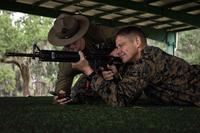UPDATED: With Gates Comments on How Old Strategy Was "Too Confining"
Clearly continuing his Augean task of reshaping the U.S. military to win the wars it is fighting, Defense Secretary Robert Gates commits the Defense Department to institutionalizing his focus in the final, official version of the Quadrennial Defense Review.
"This is truly a wartime QDR. For the first time, it places the current conflicts at the top of our budgeting, policy, and program priorities, thus ensuring that those fighting America's wars and their families - on the battlefield, in the hospital, or on the home front - receive the support they need and deserve," Gates says in his opening note to the QDR.
The biggest change between the draft QDR and the final, official version: the final version keeps the basic two major theater war shaping function, which the draft had scrapped. [We hereby retract our earlier reporting that the end of the two theater war strategy was "official",,,]
"In the mid- to long term, U.S. military forces must plan and prepare to prevail in a broad range of operations that may occur in multiple theaters in overlapping time frames. This includes maintaining the ability to prevail against two capable nation-state aggressors, but we must take seriously the need to plan for the broadest possible range of operations-from homeland defense and defense support to civil authorities, to deterrence and preparedness missions-occurring in multiple and unpredictable combinations," the final QDR says. We obtained our copy from Capitol Hill, just after aides received their official copies.
However, Gates offered some refinement to the QDr's wording during his budget briefing. He said the new approach took into account "not just two major conflicts but a broad range of other conflicts as well," he said. at the same time, Gates said his guidance going into the QDR was that the old two MTW construct was "too confining and did not represent the real world." So it would seem that the bottom line is that the Pentagon sort of scrapped the old strategy by adding a few layers to it to make it more flexible. Bottom line, however, is that the Defense Department will still first plan to be able to react to two major conflicts, as well as to be able to handle a wider range of problems.
I can't remember that last time a final document contained such a large shift from its draft. All the reporters can hear the public affairs types saying, "That's why we don't release pre-decisional documents..."
The best explanation for the change is that Defense Secretary Robert Gates sat down and said something like, we still face North Korea, Iran and one or two up and coming powers that could become threats (like China). Given that, how can we responsibly scrap the two MTW construct, no matter how much we may want to. Perhaps the QDR Red team, led by Andrew Marshall, legendary head of the Net Assessment Office, and his acolyte, Andrew Krepinevich, pushed back on this one.
We reported earlier that the High End Asymmetric Threat (HEAT) team was driving the QDR. They were looking at the threat posed by a “near peer” competitor armed with an inventory of advanced “anti-access” weapons: anti-satellite systems, increasingly accurate ballistic missiles, anti-air weapons, anti-ship systems, undersea warfare systems and cyber attacks. This may have provided the analytic basis for the decision to keep the two MTW approach.
Gates also offers a broad-brush summary of the QDR's high points, noting that: To meet the potential threats to our military's ability to project power, deter aggression. and come to the aid of allies and partners, this QDR directs more focus and investment in a new air-sea battle concept, long-range strike, space and cyberspace, among other conventional and strategic modernization programs. Furthermore, this review brings fresh focus to the importance of preventing and deterring conflict by working with and through allies and partners. along with better integration with civilian agencies and organizations."







